# 一、File
File 类(磁盘操作)可以用于表示文件和目录的信息,但是它不表示文件的内容。递归地列出一个目录下所有文件:
public static void listAllFiles(File dir) {
if (dir == null || !dir.exists()) {
return;
}
if (dir.isFile()) {
System.out.println(dir.getName());
return;
}
for (File file : dir.listFiles()) {
listAllFiles(file);
}
}
2
3
4
5
6
7
8
9
10
11
12
# 二、IO 概述
什么是 IO: 磁盘与内存之间的数据交互,可以看做是一种数据的流动,按照流动方向,以内存为基准,分为输入 input 和输出 output,即流向内存的是输入流,流出内存的是输出流。Java IO操作主要是指使用 java.io包下的内容,进行输入、输出操作。输入也叫读取数据,输出也叫写出数据。
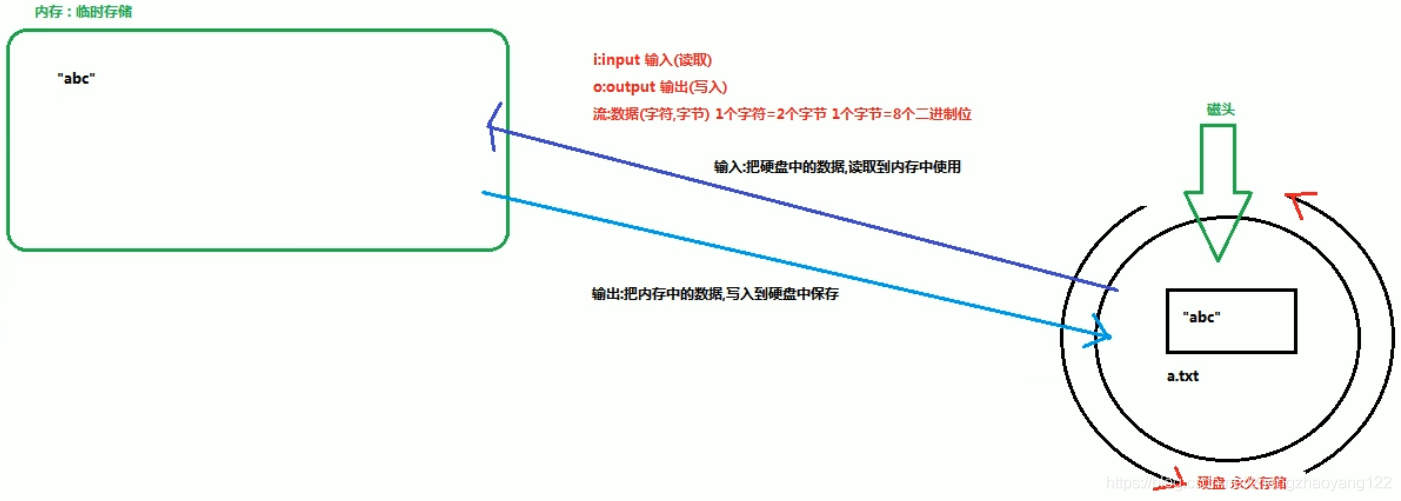
IO 的分类: 根据数据的流向分为:输入流和输出流。根据数据的类型分为:字节流(以字节为单位)和字符流(以字符为单位)。
| 输入流 | 输出流 | |
|---|---|---|
| 字节流 | InputStream | OutputStream |
| 字符流 | Reader | Writer |
# 三、字节流
一切文件数据(文本、图片、视频)在存储时,都是以二进制数字的形式保存,传输时也是如此。所以,字节流可以传输任意文件数据,在操作流的时候,我们要时刻明确,无论使用什么样的流对象,底层传输始终为二进制数据。
字节输入流InputStream:java.io.InputStream抽象类是表示字节输入流的所有类的超类,可以读取字节信息到内存。它定义了字节输入流的基本共性。
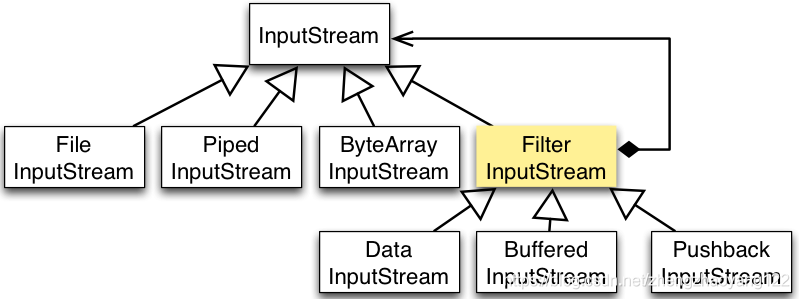
| public abstract int read() | 从输入流读取数据的下一个字节 |
| public int read(byte b[] b) | 从输入流中读取一些字节数,并将它们存储到字节数组b中 |
| public int read(byte b[] b, int off, int len) | off 写入数据的位置,数组中的起始偏移量。从输入流读取多达len字节的数据到字节数 |
| public void close() | 关闭此输入流并释放与此流相关联的任何资源 |
// 读取数据
public abstract int read()
// 将读取到的数据放在 byte 数组中,该方法实际上是根据下面的方法实现的,off 为 0,len 为数组的长度
public int read(byte b[])
// 从第 off 位置读取 len 长度字节的数据放到 byte 数组中,流是以 -1 来判断是否读取结束的
public int read(byte b[], int off, int len)
// 跳过指定个数的字节不读取,想想看电影跳过片头片尾
public long skip(long n)
// 返回可读的字节数量
public int available()
// 读取完,关闭流,释放资源
public void close()
// 标记读取位置,下次还可以从这里开始读取,使用前要看当前流是否支持,可以使用 markSupport() 方法判断
public synchronized void mark(int readlimit)
// 重置读取位置为上次 mark 标记的位置
public synchronized void reset()
// 判断当前流是否支持标记流,和上面两个方法配套使用
public boolean markSupported()
2
3
4
5
6
7
8
9
10
11
12
13
14
15
16
17
18
19
20
21
22
23
24
25
26
字节输出流OutputStream :java.io.OutputStream抽象类是表示字节输出流的所有类的超类,它定义了字节流的基本共性功能方法。
| public abstract void write(int b) | 将指定的字节写入此输出流 |
| public void write(byte b[]) | 将 b.length字节从指定的字节数组写入此输出流 |
| public void write(byte b[], int off, int len) | 从指定的字节数组写入 len字节,从偏移量 off开始输出到此输出流 |
| public void flush() | 刷新此输出流并强制任何缓冲的输出字节被写出 |
| public void close() | 关闭此输出流并释放此流相关联的任务系统资源 |
//写入一个字节,可以看到这里的参数是一个 int 类型,对应上面的读方法,int 类型的 32 位,只有低 8 位才写入,高 24 位将舍弃。
public abstract void write(int b)
// 将数组中的所有字节写入,和上面对应的 read() 方法类似,实际调用的也是下面的方法。
public void write(byte b[])
// 将 byte 数组从 off 位置开始,len 长度的字节写入
public void write(byte b[], int off, int len)
// 强制刷新,将缓冲中的数据写入
public void flush()
// 关闭输出流,流被关闭后就不能再输出数据了
public void close()
2
3
4
5
6
7
8
9
10
11
12
13
14
# 四、文件流
FileInputStream把硬盘中的数据读取到内存中
/**
* java.io.InputStream: 字节输入流。 此抽象类是表示字节输入流的所有类的超类。
* java.io.FileInputStream extends InputStream: 文件输入流
* 作用:把硬盘文件中的数据,读取到内存中
*
* 构造方法:public FileInputStream(String name) 文件路径
* public FileInputStream(File file) 文件
* 构造方法的作用:
* 1、创建一个 FileInputStream 对象;
* 2、会把 FileInputStream对象指向构造方法中创建的文件
* java程序--JVM--OS读取方法--读取文件
* 1个中文 GBK占两个字节 UTF-8占3个字节
*/
public class MyInputStream {
public static void main(String[] args) {
FileInputStream fis = null;
/**
* JDK7 新特性【了解】 在 try 后边可以增加一个() ,在括号中定义流对象,那么这个流对象的作用域就在 try中有效,
* try 中的代码执行完毕,会自动把流对象释放,不用写 finally。多个流用 ;号隔开
* 例如: try(FileInputStream fis = new FileInputStream("test.txt");
* FileOutputStream fos = new FileOutputStream("test.txt");){}
*
* JDK9 新特性【了解】
* 在 try前边定义流对象
* 在 try 括号中引入流对象名称 ,不用写 finally
* 例如:
* FileInputStream fis = new FileInputStream("test.txt");
* FileOutputStream fos = new FileOutputStream("test.txt");
* try(fis ; fos){}
*/
try {
//1、创建 FileInputStream对象,参数为绑定的数据源
fis = new FileInputStream("D:/test.txt");
//2、读取文件 read ,当读到结尾的时候返回 -1 , 注意需要用一个变量来接收 read返回值,不要读两次
/*int len = 0;
while((len = fis.read())!= -1){
System.out.println((char)len);
};*/
/**
* 一次读取多个字节的方法,byte[] 起到缓冲作用,存储每次读取到的字节个数。数组的长度一般定义为1024(1kb)或整数倍
*/
byte[] bytes = new byte[2];
int lens = fis.read(bytes);
System.out.println(lens);//2 每次读取字节的个数
System.out.println(Arrays.toString(bytes)); //[97, 98]
System.out.println(new String(bytes));//ab
} catch (IOException e) {
e.printStackTrace();
}finally {
if(fis != null){
//3、关闭流
try {
fis.close();
} catch (IOException e) {
e.printStackTrace();
}
}
}
}
}
2
3
4
5
6
7
8
9
10
11
12
13
14
15
16
17
18
19
20
21
22
23
24
25
26
27
28
29
30
31
32
33
34
35
36
37
38
39
40
41
42
43
44
45
46
47
48
49
50
51
52
53
54
55
56
57
58
59
60
61
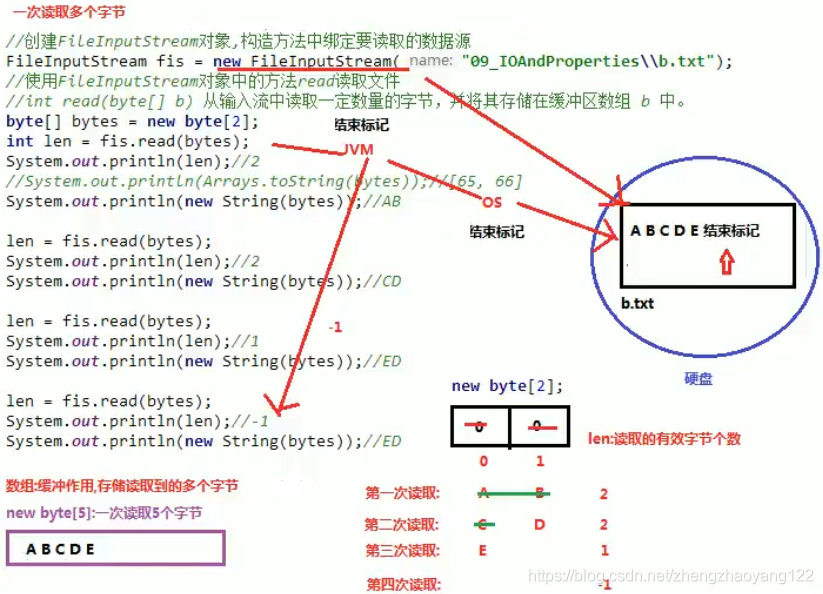
FileOutputStream把内存中的数据写入到硬盘的文件中
/**
* FileOutputStream: 文件输出流,将内存数据写入到文件中
* 构造方法: FileOutputStream(String name) 传入一个文件的路径
* FileOutputStream(File file) 传入一个文件
* FileOutputStream(String name,boolean append) 当 append为true 的时候,就不会覆盖文件,继续在文件的末尾追加写数据
* 构造方法的作用:
* 1、创建一个 FileOutputStream 对象
* 2、会根据构造方法中传递的文件/文件路径,创建一个空的文件
* 3、会把 FileOutputStream 对象指向创建好的文件
* 写数据的原理
* java程序---JVM--- OS(操作系统)---将数据写入文件中
* 写换行:换行符
* windows \r\n
* linux /n
* max /r
*/
public class MyOutputStream {
public static void main(String[] args) {
FileOutputStream fos = null;
{
try {
//1、创建一个 FileOutputStream对象
fos = new FileOutputStream("D:/test.txt");
/**
* 2、调用 FileOutputStream对象的 writer方法,将数据写入文件
* 会把十进制的整数,转为二进制存入硬盘.任意的记事本,打开时都会查询编码表,把字节转为字符表示。查询 ASKII码
* 所以 test.txt中存的是 d
*/
fos.write(100);
//写出多个字节
byte[] b = "你好".getBytes();
fos.write(b);
} catch (IOException e) {
e.printStackTrace();
}finally {
if(fos != null){
//3、释放资源,流使用会占用一定的内存,因此需要释放
try {
fos.close();
} catch (IOException e) {
e.printStackTrace();
}
}
}
}
}
}
2
3
4
5
6
7
8
9
10
11
12
13
14
15
16
17
18
19
20
21
22
23
24
25
26
27
28
29
30
31
32
33
34
35
36
37
38
39
40
41
42
43
44
45
46
47
# 五、字符流
当使用字节流读取文本时,可能会有一个问题。就是遇到中文字符时,可能不会显示完整的字符,因为一个中文字符可能占用多个字节存储。所以 Java提供一些字符流,以字符为单位读写数据,专门用于处理文本文件。
字符输入流【Reader】:java.io.Reader 抽象类是读取字符流所有类的超类,可以读取字符信息到内存中。它定义了字符输入流的基本共性功能方法:
| public int read() | 从输入流读取一个字符 |
| public int read(char cbuf[]) | 从输入流中读取一些字符,并将它们存储到字符数组 cbuf中 |
| abstract public void close() | 关闭此流并释放与此流相关联的任何系统资源 |
FileReader 文件字符输入流,继承 InputStreamReader 。
/**
* 字符输入流 Reader 输入流的最顶层父类
* FileReader 构造方法:
* FileReader(String fileName)
* FileReader(File file)
* 作用:
* 1、创建一个 FileReader 对象
* 2、会把 FileReader 对象指向要读取的文件
*
*
*/
public class MyReader {
public static void main(String[] args) {
FileReader fr = null;
try {
//1、创建 FileReader对象,参数中绑定读取的资源
fr = new FileReader("test.txt");
//2、使用 read读取当个字符并返回
int len = 0;
/*while((len = fr.read()) != -1){
System.out.print((char)len); //你好!
}*/
//读取多个字符
char[] cs = new char[1024];
while((len = fr.read(cs)) != -1){
System.out.printf(new String(cs,0,len));
}
} catch (IOException e) {
e.printStackTrace();
}finally {
if(fr != null){
//3、释放资源
try {
fr.close();
} catch (IOException e) {
e.printStackTrace();
}
}
}
}
}
2
3
4
5
6
7
8
9
10
11
12
13
14
15
16
17
18
19
20
21
22
23
24
25
26
27
28
29
30
31
32
33
34
35
36
37
38
39
40
41
字符输出流【Writer】:java.io.Writer 抽象类是所有输出字符流的最顶层父类。它定义了字符输入流的基本共性功能方法:
| public void write(int c) | 写入单个字符 |
| public void write(char cbuf[]) | 写入字符数组 |
| abstract public void write(char cbuf[], int off, int len) | 写入字符数组的某一部分 |
| public void write(String str) | 写入字符串 |
| public void write(String str, int off, int len) | 写入字符串的某一部分 |
| abstract public void flush() | 刷新流的缓冲 |
| abstract public void close() | 关闭此流,但先要刷新它 |
/**
* FileWriter 文件字符输出流
* 作用:把内存中的数据写入到文件中
* 构造方法:
* public FileWriter(String fileName) 传入文件的路径
* public FileWriter(File file) 传入一个文件
* public FileWriter(String fileName , boolean append) 传入文件的路径 append=true 的时候不覆盖文件,在文件后面 append的输出
* * public FileWriter(File file , boolean append) 传入一个文件
* 构造方法的作用:
* 1、会创建一个 FileWriter对象;
* 2、会创建一个文件,根据传入的参数
* 3、将 FileWriter对象指向创建好的文件
*/
public class MyWriter {
public static void main(String[] args) {
FileWriter fw = null;
try {
//1、创建 FileWriter对象,绑定要写入数据的目的地
fw = new FileWriter("test.txt");
//2、使用 writer 将数据写入到内存缓冲区中(字符转化为字节的过程)
char[] cs = {'a','b','c'};
fw.write(cs);
fw.write("你好!");
//3、使用 flush 将缓冲区中的数据刷新到文件中
//fw.flush();
} catch (IOException e) {
e.printStackTrace();
}finally {
if(fw != null){
//4、关闭流,会触发 flush方法
try {
fw.close();
} catch (IOException e) {
e.printStackTrace();
}
}
}
}
}
2
3
4
5
6
7
8
9
10
11
12
13
14
15
16
17
18
19
20
21
22
23
24
25
26
27
28
29
30
31
32
33
34
35
36
37
38
39
# 六、Properties 集合
/**
* java.util.Properties 集合 extends Hashtable<k,v>
* Properties 类表示一个持久的属性集。Properties 可保存在流中或从流中加载。
* Properties 集合是一个唯一和 IO流相结合的集合,
* 可以使用集合中的方法 store() ,把集合中的临时数据,持久化到硬盘中
* load(), 把硬盘中的数据读取到集合中
* Properties 集合是一个双列集合,key 和 value 都是字符串
*
*/
public class MyProperties {
public static void main(String[] args) {
// 使用 Properties 集合存储数据,遍历取出数据
//1、创建 Properties 对象
Properties prop = new Properties();
//2、添加数据
prop.setProperty("you","小三");
prop.setProperty("mine","正房");
prop.setProperty("she","小四");
/**
* 3、将数据写入到磁盘中保存
* store(OutputStream out, String comments)
* store(Writer writer, String comments) 可以写中文
*/
FileReader fr = null;
FileWriter fw = null;
try {
fw = new FileWriter("test.txt");
fr = new FileReader("test.txt");
/**
* 文件中的内容如下:
* #save data
* #Sun Nov 01 16:26:13 CST 2020
* you=小三
* she=小四
* mine=正房
*/
prop.store(fw, "save data"); //第二个参数是注释
/**
* load 将文件中的数据读取:
* 存储键值对的文件中,键与值默认的连接符号可以是 =,空格(其它符号)
* # 表示注释
* 键和值默认都是字符串
*/
Properties propRead = new Properties();
propRead.load(fr);//将在数据到 Properties
Set<String> strings = propRead.stringPropertyNames();//获取 key列表
/**
* 输入为:
* you = 小三
* she = 小四
* mine = 正房
*/
for(String key: strings){
System.out.println(key + " = " + propRead.get(key));
}
} catch (IOException e) {
e.printStackTrace();
}finally {
if(fw != null && fr != null){
try {
fw.close();
fr.close();
} catch (IOException e) {
e.printStackTrace();
}
}
}
}
}
2
3
4
5
6
7
8
9
10
11
12
13
14
15
16
17
18
19
20
21
22
23
24
25
26
27
28
29
30
31
32
33
34
35
36
37
38
39
40
41
42
43
44
45
46
47
48
49
50
51
52
53
54
55
56
57
58
59
60
61
62
63
64
65
66
67
68
69
70
71
# 七、缓冲流
缓冲流也叫高效流,是对 4个基本的 Filexxx流的增强,所以也是4个流,按照数据类型分为:
【1】字节缓冲流:BufferedInputStream,BufferedOutputStream
【2】字符缓冲流:BufferedReader,BufferedWriter
缓冲流的基本原理,是在创建流对象时,会创建一个内置的默认大小的缓冲数组,通过缓冲区读写,减少系统 IO次数,从而提高效率。
字节缓冲输出流:BufferedOutputStream
/**
* 继承 OutputStream 提高写入效率
* 构造方法:
* BufferedOutputStream(OutputStream out) 创建一个新的缓冲区输出流,以将数据写入指定的底层输出流,默认缓冲区大小= 8192
* BufferedOutputStream(OutputStream out, int size) 创建一个新的缓冲区输出流,以将具体指定缓冲区大小的数据写入底层输出流
*/
public class MyBufferedOutputStream {
public static void main(String[] args) {
FileOutputStream fos = null;
BufferedOutputStream bos = null;
try {
//1、创建字节输出流 FileOutputStream
fos = new FileOutputStream("test.txt");
//2、创建缓冲流 BufferedOutputStream
bos = new BufferedOutputStream(fos);
//3、使用 writer 方法写入内部缓冲区中
bos.write("使用内部缓冲区".getBytes());
//4、flush 将内部缓冲区的数据刷新到文件中
bos.flush();
} catch (IOException e) {
e.printStackTrace();
}finally {
if(bos != null){
//5、close 关闭流,会先执行 flush后关闭
try {
bos.close(); //会自动关闭 fos.close();
} catch (IOException e) {
e.printStackTrace();
}
}
}
}
}
2
3
4
5
6
7
8
9
10
11
12
13
14
15
16
17
18
19
20
21
22
23
24
25
26
27
28
29
30
31
32
33
字节缓冲输入流:BufferedInputStream
/**
* 继承 InputStream 称为 字节缓冲输入流
* 构造方法:
* BufferedInputStream(InputStream in)
* public BufferedInputStream(InputStream in, int size)
*/
public class MyBufferedInputStream {
public static void main(String[] args) {
//1、创建 FileInputStream对象
FileInputStream fis = null;
BufferedInputStream bis = null;
try {
fis = new FileInputStream("test.txt");
//2、创建 BufferedInputStream 对象,提高 FileInputStream对象读取的效率
bis = new BufferedInputStream(fis);
//3、使用 read方法读取数据
int len = 0;
byte[] bytes = new byte[1024];
while((len = bis.read(bytes)) != -1){
System.out.println(new String(bytes,0,len));
}
} catch (IOException e) {
e.printStackTrace();
}finally {
//4、关闭流
if(bis != null){
try {
bis.close(); //自动关闭 fis
} catch (IOException e) {
e.printStackTrace();
}
}
}
}
}
2
3
4
5
6
7
8
9
10
11
12
13
14
15
16
17
18
19
20
21
22
23
24
25
26
27
28
29
30
31
32
33
34
35
BufferedWriter :新方法 newLine() 表示换行,替换了 “\r\n" BufferedReader:新方法 readLine() 读取一个文本行,读取一行数据。如果到达流末尾,则返回 null。
# 八、转换流
字符编码 Character Encoding:就是一套自然语言的字符与二进制数之间的对应规则; 字符集 Charset:也叫编码表。是一个系统支持的所有字符的集合,包括各国家文字、标点符号、图形符号、数字等。常见字符集有 ASCII、GBK、Unicode字符集。
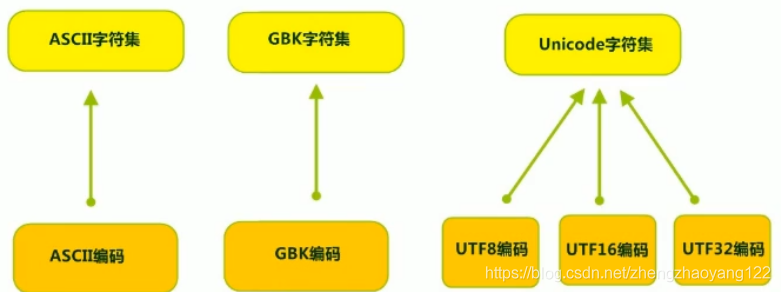
在 IDEA中,使用 FileReader读取项目中的文本文件,由于 IDEA 默认使用 UTF-8编码,所有没有任何问题。但是当读取 Windows系统中创建的文本文件时,由于 Windows系统的默认是 GBK编码,就会出现乱码。
转化流 InputStreamReader:是 Reader的子类,是从字节流到字符流的桥梁,他读取字节,并使用指定的字符集将其解码为字符,它的字符集可以由名称指定,也可以接收平台默认的字符集。
/**
* InputStreamReader:是 Reader的子类,是从字节流到字符流的桥梁,他读取字节,并使用指定的字符集将其解码为字符,它的字符集可以由名称指定,也可以接收平台默认的字符集。
* 构造方法:
* InputStreamReader(InputStream in)
* InputStreamReader(InputStream in, String charsetName)
*/
public class MyInputStreamReader {
public static void main(String[] args) {
//1、创建 InputStreamReader对象,构造方法中传入字节输入流和指定的编码表名称 指定的编码要与文件的编码相同,否则会发生乱码;
InputStreamReader isr = null;
try {
isr = new InputStreamReader(new FileInputStream("text.txt"), "GBK");
//2、使用 read 方法读取文件
int len = 0;
while((len = isr.read()) != -1){
System.out.println((char)len);
}
} catch (IOException e) {
e.printStackTrace();
}finally {
if(isr != null){
//3、释放资源
try {
isr.close();
} catch (IOException e) {
e.printStackTrace();
}
}
}
}
}
2
3
4
5
6
7
8
9
10
11
12
13
14
15
16
17
18
19
20
21
22
23
24
25
26
27
28
29
30
31
OutputStreamWriter:是 Writer的子类,是从字符流到字节流的桥梁,他写入数据,并使用指定的字符集将其编码为字符,它的字符集可以由名称指定,也可以接收平台默认的字符集。
/**
* java.io.OutputStreamWriter 继承了 Writer
* OutputStreamWriter 是字符流通向字节流的桥梁,可使用指定的 charset 将要写入流中的字符编码成字节。
* 构造方法:
* OutputStreamWriter(OutputStream out) 使用默认的字符编码
* OutputStreamWriter(OutputStream out, Charset cs) 可以指定字符编码,不区分大小写
*
*/
class MyOutputStreamWriter {
public static void main(String[] args) {
//1、创建一个 OutputStreamWriter 对象
OutputStreamWriter osw = null;
try {
osw = new OutputStreamWriter(new FileOutputStream("text.txt"), "GBK");
//2、使用 writer 写出数据
osw.write("你好");
//3、flush 刷新数据
osw.flush();
} catch (UnsupportedEncodingException e) {
e.printStackTrace();
} catch (IOException e) {
e.printStackTrace();
}finally {
//4、关闭流
if(osw != null){
try {
osw.close();
} catch (IOException e) {
e.printStackTrace();
}
}
}
}
}
2
3
4
5
6
7
8
9
10
11
12
13
14
15
16
17
18
19
20
21
22
23
24
25
26
27
28
29
30
31
32
33
34
# 九、序列化流
把对象以流的方式写入到文件中保存,对象中不仅仅是字符,也有字节。就有了 ObjectOutputStream[对象的序列化 writeObject(p)] 和 ObjectInputStream[对象的反序列化 readObject()]
ObjectOutputStream 对象序列化流:
/**
* java.io.ObjectOutputStream extends OutputStream
* 构造器:
* ObjectOutputStream(OutputStream out) 创建写入指定 OutputStream 的 ObjectOutputStream
* 特有的成员方法:writeObject
*/
public class MyObjectOutputStream {
public static void main(String[] args) {
//1、创建 ObjectOutputStream 对象,构造方法中传递字节输出流
ObjectOutputStream oos = null;
try {
oos = new ObjectOutputStream(new FileOutputStream("text.txt"));
//2、通过 writeObject 把对象写入到文件中
oos.writeObject(new Person("张三",1));//通过二进制序列化流存储的,无法打开查看。
} catch (IOException e) {
e.printStackTrace();
}finally {
//3、关闭流
try {
oos.close();
} catch (IOException e) {
e.printStackTrace();
}
}
}
}
2
3
4
5
6
7
8
9
10
11
12
13
14
15
16
17
18
19
20
21
22
23
24
25
26
ObjectInputStream 对象反序列化流:
/**
* java.io.ObjectInputStream 继承了 InputStream 将对象从文件中读取使用
* 构造方法:
* ObjectInputStream(InputStream in) 创建从指定 InputStream 读取的 ObjectInputStream
* 特有的方法:
* readObject() 返回一个 object对象
*
* transient 关键字:
* static 关键字:静态关键字,被 static修饰的成员变量不能被序列化的,序列化的都是对象的默认值。transient 与 static的作用是一样的,但却没有 static的含义
* Person对象需要实现 Serializable 并且要定义序列化ID
* 集合类的存储和对象相同
*/
public class MyObjectInputStream {
public static void main(String[] args) {
//1、创建 ObjectInputStream对象,构造方法中传递字节输入流
ObjectInputStream ois = null;
try {
ois = new ObjectInputStream(new FileInputStream("text.txt"));
//2、使用 readObject 方法读取对象
Person o = (Person)ois.readObject();
//4、对象使用
} catch (Exception e) {
e.printStackTrace();
}finally {
if(ois != null){
//3、释放资源
try {
ois.close();
} catch (IOException e) {
e.printStackTrace();
}
}
}
}
}
2
3
4
5
6
7
8
9
10
11
12
13
14
15
16
17
18
19
20
21
22
23
24
25
26
27
28
29
30
31
32
33
34
35
36
# 十、打印流
PrintStream:我们常用的 System.out.println 就是打印流。
/**
* 可以打印各种数据值表示形式,不会抛出 IOException,有特有的方法 print println
* 构造方法:
* PrintStream(File file) 输出的是一个文件
* PrintStream(OutputStream out) 输出的是一个字节输出流
* PrintStream(String fileName) 输出的是一个文件路径
* 继承了 OutputStream 拥有该成员中的方法
* 注意事项:如果使用继承自父类中的 write方法写数据,那么会查询编码表。如果使用 print 就会原样使用。
* 可以改变输出语句的目的地:System.setOut() 目的地通过参数传递
*/
public class MyPrintStream {
public static void main(String[] args) throws FileNotFoundException {
//创建打印流,绑定要输出的目的地
PrintStream ps = new PrintStream("text.txt");
//使用 write 和 print写数据
ps.write(97);//文件中为 a
ps.print(97);//文件中为 97
//设置输出流打印的目的地
System.setOut(ps);
System.out.println("此打印信息会在 text.txt文件中显示");
//释放资源
ps.close();
}
}
2
3
4
5
6
7
8
9
10
11
12
13
14
15
16
17
18
19
20
21
22
23
24
# 十一、网络通信
【1】InetAddress:用于表示网络上的硬件资源,即 IP地址。没有公有的构造函数,只能通过静态方法来创建实例。
InetAddress.getByName(String host);
InetAddress.getByAddress(byte[] address);
2
【2】URL:统一资源定位符。可以直接从 URL中读取字节流数据。
public static void main(String[] args) throws IOException {
URL url = new URL("http://www.baidu.com");
/* 字节流 */
InputStream is = url.openStream();
/* 字符流 */
InputStreamReader isr = new InputStreamReader(is, "utf-8");
/* 提供缓存功能 */
BufferedReader br = new BufferedReader(isr);
String line;
while ((line = br.readLine()) != null) {
System.out.println(line);
}
br.close();
}
2
3
4
5
6
7
8
9
10
11
12
13
14
15
16
17
18
19
20
【3】Sockets:使用 TCP协议实现网络通信;ServerSocket:服务器端类,Socket:客户端类。服务器和客户端通过 InputStream 和 OutputStream 进行输入输出。
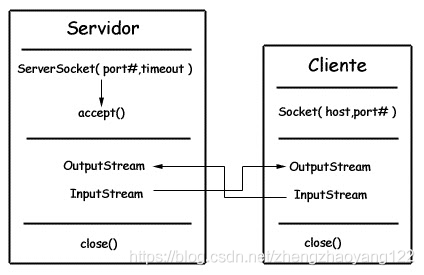
【4】Datagram:使用 UDP协议实现网络通信。DatagramSocket:通信类。DatagramPacket:数据包类。
思考: Java 字节读取流的 read方法返回 int的原因?
读取二进制数据按字节读取,每次读一个字节(byte)。read()的底层是由 C++实现的,返回的是 unsigned byte,取值范围为[0~255],在 java中 byte只能表示 [-128,127]的无符号数,所以只能用 int类型接收,Java接收得到的就是 int[0~255]。
← Java开发人员常犯错误 Atomic →